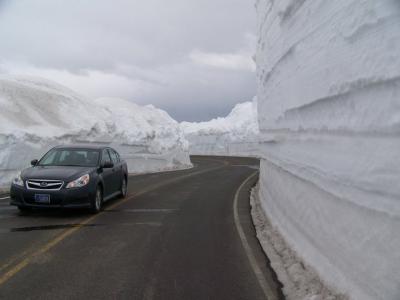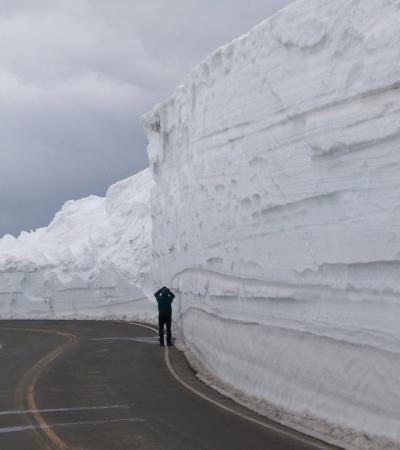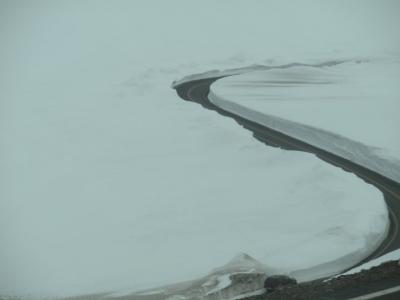HERE WE GO AGAIN. 150,000 CFS WOULD BE MAX OUT OF OAHE. NOT. RAISED TO 155,000CFS TODAY THEN 160,000CFS TOMORROW. I THINK THEY’VE LOST IT, HAVE NO CLUE WHAT TO DO NOW.
IDO » Forums » Fishing Forums » General Discussion Forum » THE CORP OF ENGINERS REALY
THE CORP OF ENGINERS REALY
-
June 18, 2011 at 2:54 pm #974217
Will it ever stop?
I am thinking about releasing my boat wench and tying a rope from one cleat to my house. Then when the water lifts the boat off the trailer, I can pull it to my front door and escape. Genius!
Seriously…
This is the saddest thing I’ve ever been close to. We will be rebuilding for many years to come down river from you. And to think it was preventable makes the whole thing that much more tragic.
Good luck to all who lie in the river’s path.June 18, 2011 at 4:32 pm #974233Hard to prevent,BUT MAN are you guys in my thoughts, I cant imagine. I had an uncle in Pierre lucky he got out 2 weeks before the flood! Best of luck to all involved
 June 18, 2011 at 9:10 pm #974256
June 18, 2011 at 9:10 pm #974256Quote:
HERE WE GO AGAIN. 150,000 CFS WOULD BE MAX OUT OF OAHE. NOT. RAISED TO 155,000CFS TODAY THEN 160,000CFS TOMORROW. I THINK THEY’VE LOST IT, HAVE NO CLUE WHAT TO DO NOW.
How bad did the town get hit ? Pic.?
June 18, 2011 at 10:15 pm #974259From what I understand Bismark is much worse. Most pictures are on keloland.com , Pierre, Yankton, and Dakota Dunes. More sites out there but don’t remember them at the moment. also check out the web site http://disasterrecovery.sd.gov/Photogal/Pierre/gallery_Jun6.aspx like the swirl above the dam over the stilling basin intake.
June 19, 2011 at 12:13 am #974273Classification: UNCLASSIFIED
Caveats: NONEST. PAUL DISTRICT
June 18, 2011
MVP-PA-2011-119
Mark Davidson: 651-290-5201, 651-261-6769, [email protected]Corps increasing outflow at North Dakota’s Lake Darling Dam to 8,100 cfs
todayST. PAUL, Minn. – The U.S. Army Corps of Engineers, St. Paul District,
increased outflow from Lake Darling Dam, which is located near Minot, N.D.,
from 7,800 to 8,100 cubic feet per second this evening.An increase in discharges is necessary because of the rain events in Canada.
The watershed for Rafferty and Boundary dams experienced large rainfalls over
the past two days. The current operating plan has Lake Darling Dam
increasing outflows up to 8,100 cfs and holding at that level for at least
two and one-half weeks. Lake Darling is currently at an elevation of 1600.35
feet and has some storage available for the anticipated inflows.For up-to-date predictions and forecasts for the North Dakota communities of
Minot, Logan, Sawyer, Velva, Towner and Bantry go to:
http://water.weather.gov/ahps2/index.php?wfo=bis.The U.S. Army Corps of Engineers, St. Paul District, serves the American
public in the areas of environmental enhancement, navigation, flood damage
reduction, water and wetlands regulation, recreation sites and disaster
response. It contributes around $175 million to the five-state district
economy. The 700 employees work at more than 40 sites in five upper-Midwest
states. For more information, see http://www.mvp.usace.army.mil.-30-
Web site: http://www.mvp.usace.army.mil/
Facebook: http://www.facebook.com/usace.saintpaul?ref=ts
Flickr: http://www.flickr.com/photos/usace-stpaul/
YouTube: http://www.youtube.com/usacemvppaoClassification: UNCLASSIFIED
Caveats: NONE inge66
Posts: 366June 19, 2011 at 12:47 am #974276
inge66
Posts: 366June 19, 2011 at 12:47 am #974276This is my father in law at Riv-R-Land Estates near the Dakota Dunes in South Dakota. Not good.
 sandmannd
Posts: 928June 19, 2011 at 12:56 am #974278
sandmannd
Posts: 928June 19, 2011 at 12:56 am #974278My folks live in Bismarck. From what they have found out the dam was kept at 98% full. Now when the waters rose they had no where to store it and are flooding everyone. Don’t they get paid big bucks to ensure the safety of us? Why not keep it at 80% full or how about releasing water in January when you saw record snows? Just more proof the gov’t has no clue on what they do.
June 20, 2011 at 12:04 am #974381Tough to predict all of the rain that fell in the upper areas of the Missouri River basin. They managed the reservoir levels based on the information they had and seriously doubt they knew Montana would have rainfalls 600% above normal this spring.
Simple solution, dont build or buy a house on an old river bottom.
June 20, 2011 at 1:46 am #974397This happens every year in the area we hunt.
The ranch we have is along the Sheyenne river and when the Corp decides to release water, it floods out everyone downstream. Bridges go under and fields then fill with water.
It’s great the Bald Hill dam is there but it is terrible what they do to the ranchers down stream.
June 20, 2011 at 3:16 pm #974532The Riverland Estates are by far the worst hit in this area. To this point we are lucky, the levees are still holding. South of here is a casino which is 2 miles from the river channel, now it is just an island. I think those Omaha and south will get the worst of this. We had about an inch of rain last night, and more is comming. All the drainage streams/ditches were full before the Corp releases, now there is 1 million gallons a second added to the mix, not good.
June 20, 2011 at 3:24 pm #974538Quote:
Tough to predict all of the rain that fell in the upper areas of the Missouri River basin. They managed the reservoir levels based on the information they had and seriously doubt they knew Montana would have rainfalls 600% above normal this spring.
Simple solution, dont build or buy a house on an old river bottom.
I feel bad for my friends and family who are suffering through this situation. However, I refuse to back down when they start blaming the corp. The Missouri River tributary basin is absolutely huge. When you get record upon record rain falls and large snow melt runoffs there is little they could do or plan for.
I have no facts to back this statement, but my gut says it’s probably not too far off. The Mississippi river delta has been at flood stages for many, many months. Heck, look at how high the rivers have been here in Mn the last 12 months. The upper Miss never did really go down this winter. That water along with everything from the Missouri are all headed south, compounding the problems. I’m quite sure the Corp has been doing everything in their powers to help prevent as much flooding as possible.
It’s easy to arm chair this one, but the fact is there is more water in the upper midwest than there has been in many, many years.
 fishingdad
Posts: 79June 20, 2011 at 6:44 pm #974622
fishingdad
Posts: 79June 20, 2011 at 6:44 pm #974622Predictable or not can be argued what concerns me is we are just seeing the beginnig of this disaster. It is still snowing in the upper elevations in Montana which means the real snow melt and runoff has not started yet. I think Montana started this season with 157% of normal snow pack. What all of this means is there will be high water on all of the levees for months and most levees are not built to withstand having water on them for extended periods. So they will soften and become water logged and possibley fail. Living along the Mississippi River we have had our share of floods and my heart and prayers go out to everyone in the path of the disater on the Missouri. Right now the reservoirs along the Missouri are holding enough water to cover the entire state of Iowa with 2 1/2 ft of water. That is a lot of water 23.8 Trillion gallons if my calculations are correct. I have a son living in Council Bluffs and hope that everyone remains safe during this event.
June 21, 2011 at 1:04 am #974723X2 it’s easy to blame the corps for everything bad that happens as we all know the corps has conrtol over mother nature and tells everyone where to build and live so she can cause millions of dollars worth of damage when she decides to
June 22, 2011 at 12:39 pm #975197I thought this was a very good article:
By CLAY JENKINSON | Posted: Sunday, June 19, 2011 1:00 am | (26) Comments
Font Size:
Default font size
Larger font size
So the finger-pointing at the U.S. Army Corps of Engineers begins.
I’m not a particular fan of the Corps of Engineers, but I think the growing tide of blame is largely misguided. The simple fact is that this is a gargantuan (I almost wrote titanic) water year in the Missouri-Mississippi basin, from Dillon, Mont., to Memphis and New Orleans.The Corps of Engineers is desperately trying to maintain control of one of the biggest water episodes on the fourth longest river in the world, the 10th most powerful, a clogged and waterlogged drainage basin that collects the runoff of all or part of 31 states and two Canadian provinces. The Missouri-Mississippi basin embraces fully 41 percent of the continental United States. It’s on the rampage this year. The corps is doing everything it can to minimize the damage from Helena and Bozeman to New Orleans, a distance of 3,709 miles. It’s a war on many fronts, and there is going to be some collateral damage, including here in North Dakota.
The corps is not the culprit. The flood of 2011 is nature’s doing (an act of God, as the insurance industry puts it), and at this point the corps is just trying to remain part of the equation to lessen the catastrophe. It’s like riding a bicycle down a very steep hill and pedaling with all your might just to maintain the illusion that you are in control, or trying to ski along the crest of an avalanche as it cascades down a mountainside. Blame the corps if you want, but if there were no dams on the Missouri River, Kirkwood Mall would be under water and people would be wading through the streets of Kansas City and St. Louis.
Damning the corps is easy, of course, and also kind of satisfying. For one thing, the Corps is handy, it’s a faceless monolithic abstraction, and best of all it’s the federal government, the universal whipping boy of the disgruntled. Besides, we North Dakotans have a longstanding legitimate quarrel with the corps, which manages the Missouri River more for the benefit of the dying barge industry below Sioux City than for the people of the Upper Basin.
Still, it is worth remembering three things. One: the corps itself is tyrannized by the outdated Flood Control Act of 1944, which gives the agency very mixed (and mutually exclusive) directives on how to manage the Missouri River. Two: Now, in the midst of this catastrophe, the corps has to try to manage the entire Missouri-Mississippi system on the utilitarian principle of the greatest good for the greatest number, or (more precisely) the least damage to the largest population and commercial centers. Hard as it is for us to accept, given the magnitude of the system-wide flood, Bismarck and Mandan are among the corps’ lesser concerns. Three: blame whom you will, but at this point there isn’t a darn thing the U.S. Army Corps of Engineers can do to help Bismarck and Mandan.
There is only one question left for the Army now. Can the corps manage the system to release as much water as possible in the next few weeks (without devastating Bismarck-Mandan, Fort Yates, Pierre, Yankton, Sioux City, Omaha, St. Joseph, Kansas City, and St. Louis) so that it can open up enough storage capacity on the six mainstem dams in time to hold back and slow down the Montana snowmelt? It’s a race against time.
Of course the corps could have released much more water from the six dams over the winter to brace the Upper Basin for “the perfect storm” of 200 percent snowpack and extensive late spring rains in Montana, but the flood along the middle and lower Mississippi River earlier this spring, which threatened Memphis and New Orleans and flooded hundreds of thousands of acres of land, forced the corps to hold back as much water as it possibly could in the Upper Basin.It was a gamble and a political choice. The gamble was that the 2011 Upper Basin conditions would not quite overwhelm the system. That gamble was lost in Montana rains that could not have been predicted. The choice was to protect the large downstream population centers to the possible, but not certain, detriment of the less densely populated upstream communities. If the dikes in Bismarck-Mandan hold for the next two months, that decision will be vindicated, however frustrating it will seem to those who lose their homes or spend the summer as high ground refugees.
The almost daily arrival of moderate to heavy rains is making me nervous. Not only because my garden is now a moist mass of weeds and the streets of Bismarck are apparently dissolving pothole by pothole, but all that water has to go somewhere. I’m no hydrologist but in my simplistic thinking it goes something like this: The six Pick-Sloan dams are all chock full. The land is saturated. Heavy rains in eastern Montana are what caused the flood in the first place. These new rains — including last Sunday night’s magnificent thunderstorm — are topping up an already brimming reservoir storage system. And the entire Montana snowmelt is still to come. We have been assured by experts that the heavy rains are not making much of a difference, but twice in the last week the street in front of my house has turned into a kind of paved creek. These rains have blanketed much of western and central North Dakota. Lake Oahe is full and backing up. Lake Sakakawea is full and spilling. It seems to me that our problems are being compounded — perhaps disastrously — by immoderate June rains.
As I wrote this (Wednesday morning), Fort Peck was taking in 79,000 cubic feet per second, and releasing 65,800. Garrison was taking in 180,000 cfs and releasing just 140,100. “Just!” Oahe in: 156,000 cfs. Oahe out: 152,200 cfs. Trouble ahead.
The drama is deepening. We’re in a cruel false lull, I think.
(Clay Jenkinson is the Theodore Roosevelt Center scholar at Dickinson State University, as well as Distinguished Scholar of the Humanities at Bismarck State College. He can be reached at [email protected] or through his website, Jeffersonhour.org.)June 22, 2011 at 1:36 pm #975232Sad part is, the central parts of SD yesterday received another 3-8 inches of rain yesterday depending on the area. My dad’s farm received 3.65 inches as of yesterday at 4:30PM. This was in about a 36 hour stretch. Mother nature is a relentless old girl.
 June 22, 2011 at 1:45 pm #975239
June 22, 2011 at 1:45 pm #975239The ol MN and ‘sippi aren’t helping either.
Soon we’ll be worried about the ocean flooding.
 June 22, 2011 at 2:19 pm #975251
June 22, 2011 at 2:19 pm #975251These pics were taken June 17th, 2011 on the Beartooth Path near Cooke City, Montana. A little snow to melt yet….


 June 22, 2011 at 2:25 pm #975254
June 22, 2011 at 2:25 pm #975254That is such a cool road!
I don’t think all the snow melts there each year though. Certainly those pictures show more than I’ve ever seen at this time of year.
Not only is it a mess, but it’s going to get worse.
June 22, 2011 at 2:31 pm #975260Could you even begin to imagine what that road would look like in MN, if we had that much snow? Guessing it would not even get touched.
 June 23, 2011 at 12:42 am #975448
June 23, 2011 at 12:42 am #975448 No it’s still the corps fault haven’t ya heard from all of the people in the know
No it’s still the corps fault haven’t ya heard from all of the people in the know
You must be logged in to reply to this topic.

